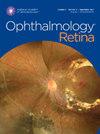Detection of Macular Neovascularization in Eyes Presenting with Macular Edema using OCT Angiography and a Deep Learning Model
IF 5.7
Q1 OPHTHALMOLOGY
引用次数: 0
Abstract
Purpose
To test the diagnostic performance of an artificial intelligence algorithm for detecting and segmenting macular neovascularization (MNV) with OCT and OCT angiography (OCTA) in eyes with macular edema from various diagnoses.
Design
Prospective cross-sectional study.
Participants
Study participants with macular edema due to either treatment-naïve exudative age-related macular degeneration (AMD), diabetic macular edema (DME), or retinal vein occlusion (RVO).
Methods
Study participants were imaged with macular 3 × 3–mm and 6 × 6–mm spectral-domain OCTA. Eyes with exudative AMD were required to have MNV in the central 3 × 3–mm area. A previously developed hybrid multitask convolutional neural network for MNV detection (aiMNV), and segmentation was applied to all images, regardless of image quality.
Main Outcome Measures
Sensitivity, specificity, positive predictive value, and negative predictive value of detecting MNV and intersection over union (IoU) score and F1 score for segmentation.
Results
Of 114 eyes from 112 study participants, 56 eyes had MNV due to exudative AMD and 58 eyes with macular edema due to either DME or RVO. The 3 × 3–mm OCTA scans with aiMNV detected MNV with 96.4% sensitivity, 98.3% specificity, 98.2% positive predictive value, and 96.6% negative predictive value. For segmentation, the average IoU score was 0.947, and the F1 score was 0.973. The 6 × 6–mm scans performed well; however, sensitivity for MNV detection was lower than 3 × 3–mm scans due to lower scan sampling density.
Conclusions
This novel aiMNV algorithm can accurately detect and segment MNV in eyes with exudative AMD from a control group of eyes that present with macular edema from either DME or RVO. Higher scan sampling density improved the aiMNV sensitivity for MNV detection.
Financial Disclosure(s)
Proprietary or commercial disclosure may be found in the Footnotes and Disclosures at the end of this article.
利用光学相干断层血管造影术和深度学习模型检测出现黄斑水肿的眼睛中的黄斑新生血管。
目的:测试人工智能算法的诊断性能,该算法可通过光学相干断层扫描(OCT)和OCT血管造影(OCTA)检测和分割不同诊断结果的黄斑水肿患者的黄斑新生血管(MNV):前瞻性横断面研究:研究对象:患有黄斑水肿的研究人员,其黄斑水肿的原因包括未经治疗的渗出性年龄相关性黄斑变性(AMD)、糖尿病性黄斑水肿(DME)或视网膜静脉闭塞(RVO):对参加研究的人员进行黄斑 3x3 毫米和 6x6 毫米光谱域 OCTA 扫描。患有渗出性黄斑变性的眼睛必须在中心 3x3 毫米区域有 MNV。之前开发的用于MNV检测和分割的混合多任务卷积神经网络(aiMNV)适用于所有图像,与图像质量无关:主要结果指标:检测 MNV 的灵敏度、特异性、阳性预测值 (PPV) 和阴性预测值 (NPV);以及分割的交集大于联合(IoU)得分和 F1 分数:在112名研究参与者的114只眼睛中,56只眼睛因渗出性AMD而出现MNV,58只眼睛因DME或RVO而出现黄斑水肿。使用aiMNV的3x3毫米OCTA扫描检测出MNV的灵敏度为96.4%,特异度为98.3%,PPV为98.2%,NPV为96.6%。在分割方面,平均 IoU 得分为 0.947,F1 得分为 0.973。6x6 毫米扫描表现良好;然而,由于扫描取样密度较低,MNV 检测灵敏度低于 3x3 毫米扫描:结论:这种新颖的 aiMNV 算法能准确检测和分割渗出性 AMD 患者眼中的 MNV,而对照组患者的黄斑水肿则是由 DME 或 RVO 引起的。扫描取样密度越高,aiMNV 对 MNV 检测的灵敏度就越高。
本文章由计算机程序翻译,如有差异,请以英文原文为准。
求助全文
约1分钟内获得全文
求助全文

 求助内容:
求助内容: 应助结果提醒方式:
应助结果提醒方式:


